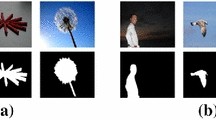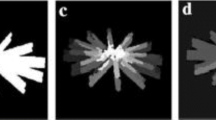Abstract
A salient region is part of an image that captures the highest level of attention by the human visual system. In this paper, a new salient region detection method is proposed by linearly combining the feature maps for the L, a and b color channels. Since, the wavelet transform is capable of providing a multi-scale spatial-frequency decomposition of the image, the color feature maps are obtained using this transform. A scheme is proposed whereby the channel feature maps are linearly combined. The weights for the linear combination are determined by making use of the entropy of the channel feature maps and a Gaussian kernel, utilizing the fact that the salient objects are generally clustered and scene-centric. The salient region is further refined by making use of the proximity of the pixels to the centers of gravity in the image feature map. Extensive simulations are conducted in order to evaluate the performance of the proposed saliency detection scheme by applying it to the natural images from several datasets. Experimental results show that the proposed method provides values of precision, recall and F-measure larger than and that of the mean absolute error smaller than those provided by other existing methods. The performance of the proposed salient region detection method is also evaluated on noisy images and it is shown to be robust against noise.

















Similar content being viewed by others
References
Abkenar MR, Ahmad MO (2015) Quaternion-based salient region detection using scale space analysis. In: Proceedings signal processing and intelligent systems conference (SPIS), pp 78–82
Abkenar MR, Ahmad MO (2016) Superpixel-based salient region detection using the wavelet transform. In: Proceedings IEEE international symposium on circuits and systems (ISCAS), pp 2719–2722
Achanta R, Hemami SS, Estrada FJ, Susstrunk S (2009) Frequency tuned salient region detection. In: Proceedings IEEE conference on computer vision and pattern recognition (CVPR), pp 1597–1604
Arya R, Singh N, Agrawal R (2016) A novel hybrid approach for salient object detection using local and global saliency in frequency domain. Multimedia Tools and Applications 75(14):8267–8287
Avidan S, Shamir A (2007) Seam carving for content-aware image resizing. ACM Trans Graph 26(3):10
Batra D, Kowdle A, Parikh D, Luo J, Chen T (2010) iCoseg: Interactive Co-segmentation with Intelligent Scribble Guidance. In: Proceedings IEEE conference on computer vision and pattern recognition (CVPR), pp 3169–3176
Borji A (2015) Salient object detection: a benchmark. IEEE Trans Image Process 24(12):5706–5722
Borji A, Itti L (2013) State-of-the-art in visual attention modeling. IEEE Trans Pattern Anal Mach Intell 35(1):185–207
Borji A, Cheng M, Jiang H (2014) Salient object detection: A survey. arXiv:1411.5878
Bruce N, Tsotsos J (2005) Saliency based on information maximization. Adv Neural Inf Proces Syst 18:155–162
Cheng, Mitra N, Huang X, Torr P, Hu S (2015) Global contrast based salient region detection. IEEE Trans Pattern Anal Mach Intell 37(3):569–582
Fugal D (2009) Conceptual wavelets in digital signal processing: an in-depth practical approach for the non-mathematician. Space and Signals Technical Publishing, San Diego
Goferman S, Zelnik-Manor L, Tal A (2012) Context-aware saliency detection. IEEE Trans Pattern Anal Mach Intell 34(10):1915–1926
Guo C, Ma Q, Zhang L (2008) Spatio-temporal saliency detection using phase spectrum of quaternion Fourier transform. In: Proceedings IEEE conference on computer vision and pattern recognition (CVPR), pp 1–8
Harel J, Koch C, Perona P (2006) Graph-based visual saliency. Adv Neural Inf Proces Syst 1(2):545–552
Hou X, Zhang L (2007) Saliency detection: A spectral residual approach. In: Proceedings IEEE conference on computer vision and pattern recognition (CVPR), pp 1–8
Itti L (2004) Automatic foveation for video compression using a neurobiological model of visual attention. IEEE Trans Image Process 13(10):1304–1318
Imamoglu N, Lin W, Fang Y (2013) A saliency detection model using low-level features based on wavelet transform. IEEE Trans Multimedia 15(1):96–105
Itti L, Koch C, Niebur E (1998) A model of saliency-based visual attention for rapid scene analysis. IEEE Trans Pattern Anal Mach Intell 20(11):1254–1259
Ko B, Nam J (2006) Object-of-interest image segmentation based on human attention and semantic region clustering. J Opt Soc Am A 23(10):2462–2470
Koffka K (1935) Principles of Gestalt psychology. Routledge, London
Li J, Levine M, An X, Xu X, He H (2013) Visual saliency based on scale-space analysis in the frequency domain. IEEE Trans Pattern Anal Mach Intell 35 (4):996–1010
Liu S, Hu J (2016) Visual saliency based on frequency domain analysis and spatial information. Multimedia Tools and Applications 75(23):16699–16711
Liu T, Yuan Z, Sun J, Wang J, Zheng N, Tang X, Shum H (2011) Learning to detect a salient object. IEEE Trans Pattern Anal Mach Intell 33(2):353–367
Ma YF, Zhang HJ (2003) Contrast-based image attention analysis by using fuzzy growing. In: Proceedings ACM international conference on multimedia, pp 374–381
Merry RJ (2005) Wavelet theory and application: a literature study. Eindhoven University of Technology, Eindhoven
Murray N, Vanrell M, Otazu X, Parraga CA (2011) Saliency estimation using a non-parametric low-level vision model. In: Proceedings IEEE conference on computer vision and pattern recognition (CVPR), pp 433–440
Sun L, Tang Y, Zhang H (2016) Visual saliency detection based on multi-scale and multi-channel mean. Multimedia Tools and Applications 75(1):667–684
Tian Q, Sebe N, Lew M, Loupias E, Huang T (2001) Image retrieval using wavelet-based salient points. J Electron Imaging 10(4):835–849
Tomasi C, Manduchi R (1998) Bilateral filtering for gray and color images. In: Proceedings IEEE conference on computer vision and pattern recognition (CVPR), pp 839–846
Walther D, Koch C (2006) Modeling attention to salient proto-objects. Neural Netw 19(9):1395–1407
Xie X, Zaitsev Y, Velasquez-Garcia L, Teller S, Livermore C (2014) Compact, scalable, high-resolution, MEMS-enabled tactile displays. In: Proceedings solid-state sensors, actuators, and microsystems workshop, pp 127–130
Xu X, Mu N, Chen L, Zhang X (2016) Hierarchical salient object detection model using contrast-based saliency and color spatial distribution. Multimedia Tools and Applications 75(5):2667–2679
Yan Q, Xu L, Shi J, Jia J (2013) Hierarchical saliency detection. In: Proceedings IEEE conference on computer vision and pattern recognition (CVPR), pp 1155–1162
Yuan Y, Wang J, Li B, Meng MQ (2015) Saliency based ulcer detection for wireless capsule endoscopy diagnosis. IEEE Trans Med Imaging 34(10):2046–2057
Zhang L, Lin W (2013) Selective visual attention: computational models and applications. Wiley, New York
Zhang GX, Cheng MM, Hu SM, Martin RR (2009) A shape-preserving approach to image resizing. Comput Graphics Forum 28(7):1897–1906. Blackwell, New York
Zhou C, Liu C (2015) An efficient segmentation method using saliency object detection. Multimedia Tools and Applications 74(15):5623–5634
Acknowledgements
This work was supported in part by the Natural Sciences and Engineering Research Council (NSERC) of Canada and in part by the Regroupement Strategique en Microelectronique du Quebec (ReSMiQ).
Author information
Authors and Affiliations
Corresponding author
Rights and permissions
About this article
Cite this article
Rezaei Abkenar, M., Ahmad, M.O. Salient region detection using efficient wavelet-based textural feature maps. Multimed Tools Appl 77, 16291–16317 (2018). https://doi.org/10.1007/s11042-017-5199-3
Received:
Revised:
Accepted:
Published:
Issue Date:
DOI: https://doi.org/10.1007/s11042-017-5199-3




